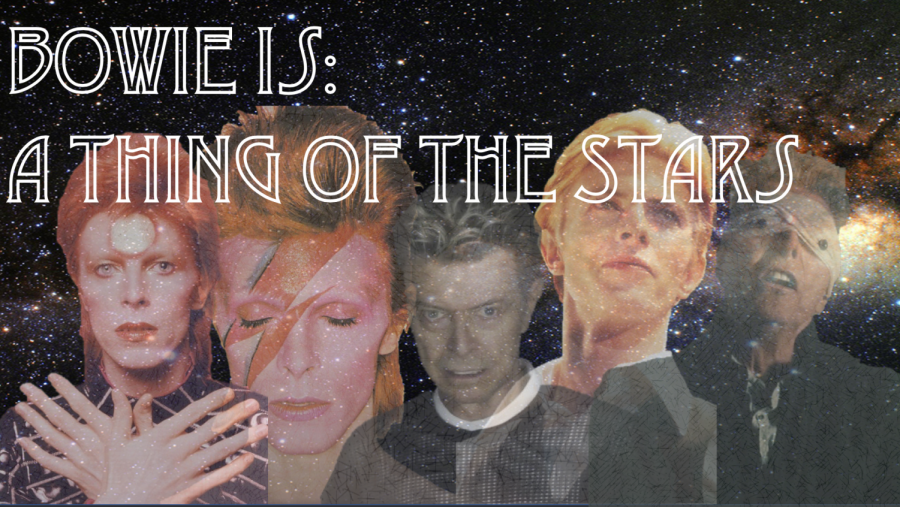With how different each individual is, it’s as if the human body is its own world.
Each different, yet still the same.
With storms inside, and oceans floating land.
Yet for one man, his body was less of a world and more of a universe.
Different, not the same.
With a million stars and an endless bound.
Because he was many in one. He was the eccentric Ziggy Stardust, and the wild Aladdin Sane. He was morose Thin White Duke and the provocative Blind Prophet. But to everyone he is and forever will be:
David Bowie.
Bowie’s first alias, Ziggy Stardust, was created in 1971, but first featured in Bowie’s 1972 album, The Rise and Fall of Ziggy Stardust and the Spiders from Mars. Featuring songs like “Moonage Daydream,” “Starman” and “Ziggy Stardust,” it can be argued that this album was Bowie’s crowning achievement.
“Moonage Dream” is a glam-rocking story of someone out of this world. The dream-like story is accompanied by a barrage of instruments. There is a backing piano melody throughout the song, with occasional ripping electric guitar and a soft, supportive drum section. The song is also carried by the incomparable vocals of David Bowie.
“Starman” is another Bowie epic that meanders on for over four minutes, giving an out-of-this-world experience. The hook, “There’s a starman waiting in the sky,” is iconic in itself, but it also acts as the perfect setup for the stairway, staccato vocals that come in the bridge. Overall, the song is one of Bowie’s best and sets up the idea of what the Bowie listening experience was to be.
“Ziggy Stardust” starts off with an immaculate guitar riff and just gets better from there. The song that tells the story of Ziggy Stardust. It depicts Stardust’s transition from great band member to primadonna that drove his band apart. The song acted almost as allegory for what Bowie experienced in his rise to stardom.
Bowie’s next persona, Aladdin Sane, saw the British rocker dawn a signature lightning bolt down the face on the cover of his 1973 album, Aladdin Sane. Bowie built upon the gravitas of Ziggy Stardust, by enhancing his eccentricity with another persona, and he bolstered his acclaim with the release of songs “Drive-In-Saturday,” “Panic in Detroit” and “The Jean Genie.”
“Drive-In-Saturday” has a doo-wop inspiration, but mixes it with Bowie’s iconic extra-terrestrial sound. The song builds up through its entire duration, accompanied by mo-town-esque backing vocals and Detroit-like horns. Bowie adds onto the experience with gritty, raw vocals that offer an endearing contrast to the sound of the rest of the song.
“Panic in Detroit” is one of Bowie’s hits that sounds more like a cacophony than a mellifluous song. The song is a rambling flibbertigibbet that really just makes no sense. But given Bowie’s eccentricity, it just doesn’t matter because the perception of the song is that it’s art that goes above our heads.
“The Jean Genie,” is an all-American, Midwestern, rocker. With obvious inspiration from his American tour, Bowie created a desperado anthem. The driving guitar riffs, mixed with the constant harmonica makes “The Jean Genie” a modern anthem for a Clint Eastwood figure.
Bowie then transitioned into a grittier, darker character, starkly contrasting the flamboyance of his previous personas, when he became the Thin White Duke. The Thin White Duke first appeared in 1974 during the “Philly Soul” leg of the Diamond Dogs tour. The character didn’t appear on vinyl until Bowie’s 1976 album Station to Station: an album consisting of songs like “Station to Station,” “Wild Is the Wind,” and “Golden Years.”
“Station to Station,” Bowie’s titular track of the album, is unbelievably long. Like over 10 minutes long. The first five minutes act as an intro to a funky, jazzed-up dance-bop. The upbeat temp, paired with the ragtime meets electronica style keyboard, and groovy drum track, makes this song one that you could easily dance the night away to (if you’re willing to wait five minutes to get to the actual song).
“Wild Is the Wind” is a more intimate track. Bowie trades in his usual rocking vocals for a more sensual sound, that gives the song an almost Marvin Gaye aesthetic. The love song is imagery-filled and uses a Spanish-style guitar to make it more of serenade than a glam-rock song.
“Golden Years” is another mo-town-meets-Bowie-eccentricity style of song. The backing vocals and horns give it the mo-town vibe, but Bowie’s out-of-this-world nature is what gives the song an extra flair that makes it an iconic Bowie work. The vocals are almost playful, making the song a fun-for-everyone jam that is unapologetically foot-tap-inducing.
Bowie’s final persona came in album Blackstar’s The Blind Prophet. Being the main character of Bowie’s sendoff album, he was the face of songs like “Lazarus,” “Dollar Days” and “Blackstar.”
“Lazarus” is the dark side of Bowie. The drums and saxophone set a morose scene, and the syntho-sirens make it Bowie. The lyrics tell of a man battered, and bruised, one that had it all, but didn’t want any of it. A man who felt alone in a world where everyone admired him. A man who could most aptly be described as David Bowie.
“Dollar Days” is a raw piano ballad, about the fleeting time Bowie had left. He is appreciating all the mundane things in life he once took for granted, now that his time is running out. He reminisces about the days where he made abhorrent sums of money, and how the little things didn’t matter. But now that his time is short, all those little things mean everything. It was Bowie’s way to say, “I’m dying.”
“Blackstar” is another ten-minute Bowie track. This time however, it is full of a dark sendoff to everything Bowie. It reminisces about how he was the center of the universe, how he was a god amongst men, but how now, he is merely a mortal man.
After almost 50 years of serenading the masses, Bowie’s career had finally come to a close. Capping his career off in the perfect fashion, and giving him the opportunity to look back and smile at what he had accomplished before his passing in 2016.
After Bowie’s death, our heads were at war with our hearts. Our head being supported by fact as strong as steel, while our hearts being coded in a feeble gold cast of memory. But this let Bowie give us one last show and teach us one last lesson.
That even the strongest steel can atrophy and corrode.
But that gold never rusts.















